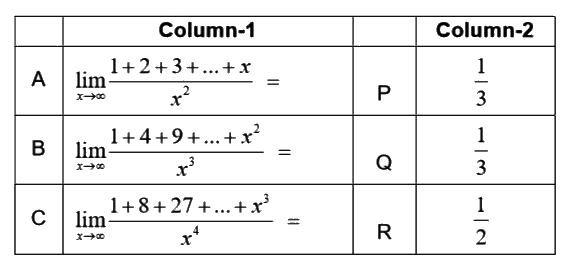Select the correct alternatives out of given four alternatives in each.
If y=sin4x+cos4x, then dydx=
4sin4x+4cos3x
4sin3x−4cos3x
−sin4x
0
The correct Answer is:C
To solve the problem, we need to differentiate the function y=sin4x+cos4x with respect to x. Let's go through the steps systematically.
Step 1: Differentiate the function
We start with the function:
y=sin4x+cos4x
We will differentiate y with respect to x:
dydx=ddx(sin4x)+ddx(cos4x)
Step 2: Apply the chain rule
Using the chain rule, we differentiate each term:
1. For sin4x:
ddx(sin4x)=4sin3x⋅ddx(sinx)=4sin3x⋅cosx
2. For cos4x:
ddx(cos4x)=4cos3x⋅ddx(cosx)=4cos3x⋅(−sinx)=−4cos3xsinx
Step 3: Combine the derivatives
Now we combine the results from the two derivatives:
dydx=4sin3xcosx−4cos3xsinx
Factoring out the common terms:
dydx=4sinxcosx(sin2x−cos2x)
Step 4: Use trigonometric identities
We can simplify sin2x−cos2x using the identity:
sin2x−cos2x=−cos(2x)
Thus, we can rewrite the derivative:
dydx=4sinxcosx(−cos(2x))
Using the double angle identity for sine:
sin(2x)=2sinxcosx
We can express 4sinxcosx as:
4sinxcosx=2sin(2x)
So, we have:
dydx=−2sin(2x)cos(2x)
Step 5: Final expression
Using the identity for sin(2x)cos(2x):
sin(2x)cos(2x)=12sin(4x)
Thus, we can write:
dydx=−sin(4x)
Conclusion
The final result is:
dydx=−sin(4x)
We start with the function:
y=sin4x+cos4x
We will differentiate y with respect to x:
dydx=ddx(sin4x)+ddx(cos4x)
Using the chain rule, we differentiate each term:
1. For sin4x:
ddx(sin4x)=4sin3x⋅ddx(sinx)=4sin3x⋅cosx
2. For cos4x:
ddx(cos4x)=4cos3x⋅ddx(cosx)=4cos3x⋅(−sinx)=−4cos3xsinx
Now we combine the results from the two derivatives:
dydx=4sin3xcosx−4cos3xsinx
Factoring out the common terms:
dydx=4sinxcosx(sin2x−cos2x)
We can simplify sin2x−cos2x using the identity:
sin2x−cos2x=−cos(2x)
Thus, we can rewrite the derivative:
dydx=4sinxcosx(−cos(2x))
Using the double angle identity for sine:
sin(2x)=2sinxcosx
We can express 4sinxcosx as:
4sinxcosx=2sin(2x)
So, we have:
dydx=−2sin(2x)cos(2x)
Using the identity for sin(2x)cos(2x):
sin(2x)cos(2x)=12sin(4x)
Thus, we can write:
dydx=−sin(4x)
The final result is:
dydx=−sin(4x)
Topper's Solved these Questions
- BOOK - CBSE COMPLEMENTARY MATERIALCHAPTER - LIMITS AND DERIVATIVES EXERCISE - SHORT ANSWER TYPE QUESTIONS10videos
LIMITS AND DERIVATIVES
- BOOK - CBSE COMPLEMENTARY MATERIALCHAPTER - LIMITS AND DERIVATIVES EXERCISE - LONG ANSWER TYPE QUESTIONS33videos
LIMITS AND DERIVATIVES
- BOOK - CBSE COMPLEMENTARY MATERIALCHAPTER - INTRODUCTION TO THREE-DIMENSIONAL COORDINATE GEOMETRYEXERCISE - SHORT ANSWER TYPE QUESTIONS20videos
INTRODUCTION TO THREE-DIMENSIONAL COORDINATE GEOMETRY
- BOOK - CBSE COMPLEMENTARY MATERIALCHAPTER - LINEAR INEQUALITIESEXERCISE - LONG ANSWER TYPE QUESTIONS (Solve to the following system of inequalities and represent solution on number line:)3videos
LINEAR INEQUALITIES
Similar Questions
Knowledge Check
- Question 1 - Select One
Select the correct alternatives out of given four alternatives in each.
limx→πsinxx−π is-A1B2C−1Ddoes not exists - Question 2 - Select One
Select the correct alternatives out of given four alternatives in each.
limx→1x+x2+x3+x4−4x−1 is-A0B4C10Ddoes not exists - Question 3 - Select One
Select the correct alternatives out of given four alternatives in each.
limx→π4sec2x−2tanx−1 is-A0B1C2D4
Select the correct alternatives out of given four alternatives in each.
Math the following:

Which of the following is true?View SolutionIf siny=xcos(a+y), then dydx=
View SolutionIf y=sin(cos(tanx)),thendydx=
View SolutionIf sin(x+y)+cos(x+y)=1,thendydx=
View SolutionIf y=sin−1(4x3−3x),thendydx=
View Solution

